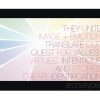It all started in 2011 when I was doing marketing consulting for some fashion brands back in Brazil. Most of them didn’t know who they were and only wanted to copy the market leaders. I tried to explain the importance of brand differentiation and used to build an ideal consumer profile, which I didn’t think was enough. And they kept copying everything…
Then, one day I saw my husband reading a book called “The Hero and the Outlaw” and judging by its cover, it looked like something about mythology. He told me it was recommended in a Design Thinking course and it was about building brand identity using archetypes. I started to read it and found what was looking for! Everything made sense. I started implementing on a few Brazilian fashion startups and in my MA dissertation deepened the research by focusing on UK luxury brands, more specifically Alexander McQueen, Stella McCartney, Burberry and Paul Smith.
The method created by authors Carol S. Pearson, a Jungian psychologist, and Margaret Mark, an advertiser who was executive vice-president at Young & Rubicam, is simple, concise, straightforward and aims in catching the brand’s ‘soul’ in order to make it consistent and easily understood by consumers, who will relate to the brand’s archetype and establish an emotional bond. As I mentioned before, archetype is a term coined by Carl Jung that represents universal, timeless, archaic patterns and images that derive from the collective unconscious. Their existence can be observed by examining cultural behaviour, art, myths, religions and dreams. Because they unite image + emotion, they translate our quest for values, virtues, purposes and stories.
To determine a brand’s archetype, the authors suggest a system that includes brainstorms, questionnaires (with employees and consumers), and competitor analysis. Semiotic may also be useful, especially in established companies, so as specific researches about historical facts and even mythology.
To give an example, in my dissertation, I used Semiotic analysis and interviews with consumers to reveal the archetypes of my chosen brands (Burberry, Alexander McQueen, Stella McCartney e Paul Smith) and to verify if they were being well communicated. In a ‘real’ client situation, I first dig in the motivation behind the brand, combined with the founder’s aspirations in order to develop a plan that will set the positioning, marketing and communication strategies.
To me, the great difference between archetype application and other methods of ‘brand identity building’ is that archetypical analysis works as a compass, offering a consistent long-run plan, always directing to the brand’s ‘north’. Traditional systems of ‘brand pyramid’ or ‘attributes’ that list a bunch of adjectives (“the brand targets a jet-setter, independent, feminine, confident woman who juggles family and professional life”…Please!) end up being superficial and fail to establish a concise and convincing communication. Archetypes help envision all aspects of a company – from product style to desirable employees profile – orchestrated in a way that feels like everyone is speaking the same language and fully aware of the emotions the brand awakens in customers.
To learn more about archetypes, click here and to see concrete examples of their power in branding take a look at these brands.




2 thoughts on “Archetypes: How to Use – Part 1”